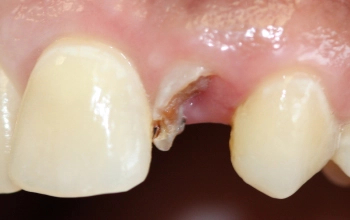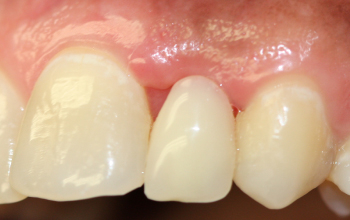
BEFORE: Decayed, Fractured Tooth

AFTER: One Week Later, with Bone Graft and Flipper
Your bone graft is made up of many small particles of bone, like “grains of sand.” You may find some small granules of particulate bone in your mouth for the first several days after surgery. Do not be alarmed by this. It’s normal to have some bone graft particles leak into the mouth.
Here are some things you can do to care for your socket bone graft after surgery:
Firm, Moist Gauze Pressure for 2 Hours: Firm, moist gauze pressure stops bleeding. Bite down firmly and do not talk during this time. Relax sitting upright in a comfortable chair watching TV. If still bleeding after 2 hours, stack and fold 3 fresh gauze, moisten with water, and apply to the wound for 1 hour at a time until bleeding stops.
Apply Cold Packs to Face: Apply bags of ice or frozen peas to each side of face. Hold bags in place with an ACE wrap, scarf, or towel. Alternate cold packs 30 minutes on and 30 minutes off for the first 48 hours. Keep head elevated on a recliner or couch while sleeping for the first 7 days to minimize swelling.
Elevate Head for the First 7 Days: Keep head elevated on a recliner or couch while sleeping for the first 7 days to minimize swelling. Do not lay flat on a bed for the first 7 days, as increased facial swelling will occur.
No Smoking: Do not smoke. Smoking slows healing and increases the risk of infection and severe dry socket pain, as well as increasing the risk of failure of the bone graft.
No Spitting: Do not spit for 1 month. Spitting can dislodge the bone graft, causing failure of the bone graft. If you feel like you need to spit, gently rinse water in your mouth and then let the water passively fall into the sink.
No Straws: Avoid straws for 1 month. Using a straw can dislodge the bone graft, causing failure of the bone graft. Eat smoothies and milkshakes with a spoon, or drink from a cup.
Diet: Day 1 – Cool, soft foods (i.e. ice cream, yogurt, smoothies, milkshakes – use a spoon, no straws). Days 2 thru 31 – Soft, room temperature food (i.e. pasta, scrambled eggs, red beans, rice, mashed potatoes). Avoid hot and spicy foods and drinks. Make sure soup and coffee has been cooled to room temperature.
Medication: Take all medications with food to help prevent nausea. Use medications as directed by prescriptions. Do not drive or operate heavy machinery after IV sedation, or if you are taking narcotic medications (i.e. codeine, hydrocodone, oxycodone, tramadol) or nausea medication (promethazine), as they impair judgement and cause drowsiness.
Rinsing: Begin GENTLE rinsing on Day 2 after each meal. Vigorous rinsing can dislodge the bone graft, causing failure of the bone graft. You may use over-the-counter alcohol-free mouthrinse or water. Rinsing keeps the mouth clean and decreases the risk of infection. Do not spit. Instead, gently rinse and then let the rinse passively fall into the sink.
Oral Hygiene: Use a soft bristle toothbrush (avoid electric toothbrush) to brush teeth normally, but avoid the bone graft surgical site. Gently rinse with over-the-counter alcohol-free mouthrinse or water, as directed by Dr. Jackson.
Activity: Frequent rest is important after surgery. Do not exercise for 1 week after surgery, as exercise can cause painful throbbing or bleeding at the surgical site.
Swelling: For the first 4-5 days after surgery, it is normal for you to experience swelling, pain, and even bruising, which then gradually disappear.
